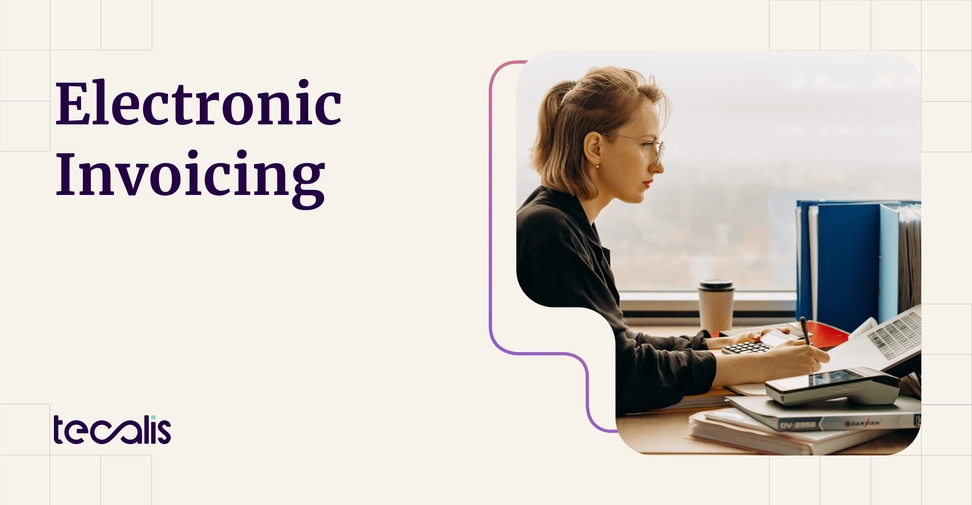Index
Get the latest news right in your inbox
Electronic invoicing is regulated in all European Union countries and 85% of them have laws requiring companies to make use of it. Did you know that in 2022 alone more than €90 billion in global VAT revenue was lost categorized as reporting errors, bankruptcies, insolvencies, or fraud related to invoicing?
It may seem an overwhelming figure, however, it is really positive considering the almost 135 billion euros in 2019. This is due to the progressive implementation of electronic invoicing systems. Controlling economic activity, preventing money laundering, and limiting losses have made electronic invoices or e-invoices a stronghold.
We will delve into this decisive tool for productivity in businesses of any size and sector, savings in time and resources as well as the fight against fraud.
What is an electronic invoice?
An electronic invoice is a digital document of a commercial and fiscal nature that legally records the purchase and sale of a good or the provision of a service. This commercial file includes basic and specific information about the transaction being carried out between two parties: the seller or service provider and the buyer or customer.
This digitalized accreditation and proof of the transfer after the purchase or service has full legal validity if it is issued, sent, and received according to the standards set by the different regulations. Also known as eInvoice or e-Invoice, this model falls within the provisions of the Invoicing Regulation (2013) according to its standards of issuance and receipt in electronic format.
The main difference between the traditional physical invoice and the new electronic invoice lies in the ability to prove the identities of the parties. Thanks to identity verification techniques, it can be legally corroborated that the persons or entities signing the invoice did so at a specific time and that it was reliably that subject (either a company or an individual).
On the other hand, both authenticity and integrity - verification that the content of the electronic invoice has not been altered - are the hallmarks of this model thanks to technologies inherent to the now standardized and officialized electronic signature.
For a digital file or document to be considered as an e-Invoice, it must have a series of specific requirements and features. Although not all electronic invoicing tools include all the possibilities and advanced functionalities such as identity verification sealed by QES electronic signature (only carried out by a QTSP), there are a series of minimum requirements that must be met:
- Complete invoice readability through standard quality file formats. Well-designed software will generate electronic invoices with correct readability.
- Guarantee of authenticity from the origin, faithfully identifying the obligor for its correct issuance as well as the issuer of the invoice. There is the possibility that it is the same subject (individual or company).
- Guarantee of content integrity, avoiding later modifications or leaving a record of when, by whom, and how they were made in case a change has occurred.
There are different methods to guarantee these minimum requirements. With their differences and similarities, all of them are valid and recognized by the administrations although they are of different application.
- Electronic Data Interchange EDI (structured data interchange between organizations).
- Through means communicated and officialized by the State Tax Administration Agencies or the European Union, which are updated as platforms and legislation progress.
More than 60% of businesses with a presence in Europe report that they do not receive their payments in a timely manner. These figures increase even more if we analyze SMEs, which are also the ones that suffer the most when these phenomena of delays and/or late payments occur. The European Union is determined to implement a model of payment without delay, not only between public administrations and companies (something in which most member states have already made considerable progress with their national and regional laws), but also in B2B environments.
The now globally standardized eIDAS Regulation serves as the basis for electronic invoicing, a fundamental pillar of which is the electronic signature with a digital certificate of the issuer of the invoice with a reliable request to the recipient through electronic means that operate under the standards of the Qualified Trusted Electronic Services (QTSP).
Types of electronic invoices

Although we can find different formats in which an electronic invoice is developed, we can group all types into two main categories: electronic invoices with structured and unstructured formats.
The types of original invoices: ordinary, simplified, recapitulative, and rectifying remain unchanged. As these are due to the content of the invoice, it is independent of whether it is an electronic or physical invoice.
Electronic invoicing in a structured format
The types belonging to this category are characterized by being simple and standardized. This greatly facilitates the automation of their dispatch, delivery, and processing. Structured e-invoices can be generated autonomously by e-invoicing platforms and applications and processed automatically by the systems used in the recipients' accounting equipment.
- Electronic invoices in XML language (used by Facturae and in UBL 2.1, Universal Business Language, or CII, one of the preferred by public administrations). These are usually accompanied by the use of PDF files.
- Facturae format (v3.1, v3.2, v3.2.2). It is the standardized one to work with the public administration although it has already been extended to B2B use. It is XML-based but follows the standards set by the Ministry of Industry and Commerce, including electronic signature. These are compatible with the FACe and e.FACT directories of AOC (used by the administrations, the latter in Catalonia).
- FACeB2B, used for business-to-business transactions connected to the administration.
- PDF signed with eIDAS electronic signature.
- EDIFACT, the UN standard for data exchange in international environments.
- PEPPOL Network and eDelivery, a European electronic communications system for public purchasers and procurement processes. It is a set of technical specifications for integration into eProcurement platforms and eBusiness services that achieve interoperability between non-peer-to-peer systems in the European Union.
- Those of some banking institutions such as BS Invoice.
- Sending in FTP methods for direct deposit on the receiver's servers. Sometimes JSON format is also used for structured data either via FTP or not.
We have seen that therefore in this format of structured electronic invoices, the information, data, and content of the invoice are organized in fields and encoded through a defined standard, such as the ones we have just seen. Each field and area is defined with a name and a specific value, something that allows easy identification and processing of the invoice content, even including identity data and electronic certificates.
Electronic invoicing in an unstructured format
They are mainly images with generally non-indexable content. Their data do not respond to any of the above standards but are valid if the requirements mentioned at the beginning of this article are met in order to be considered an electronic invoice. This includes scans, indexable PDFs, and others in plain format without virtual text but correctly readable, as well as DOC, HTML, or TXT (which can sometimes be structured), XLS, JPEG, PNG, GIF, among others.
The introduction of unstructured electronic invoices into the recipient's systems is complex and requires time and manual work by qualified personnel. This can be solved with Optical Character Recognition (OCR) software, which extracts the content and creates a structured copy, which is stored together with the unstructured one in a package, processed, and stored; however, most companies do not have these sophisticated systems.
When will electronic invoicing be mandatory in Spain?
Electronic invoicing has been mandatory in Spain for a decade. In December 2013, Law 25/2013 was passed, which requires the creation of an accounting register of invoices for transactions between companies and administrations. In other words, the obligation to issue electronic invoices is present for all those companies working with the public sector.
On the other hand, Royal Decree-Law 16/2013 acted as a transposition already at the time of several European directives aimed at the use of electronic invoicing and the fight against fraud both in administrations and between companies and individuals.
More and more regulatory bodies are focusing on invoicing, with a firm commitment and a fixed timetable. In Europe, the electronic invoicing standard CEN-TC/434 was the first international precedent in the EU to set the mandatory use for B2G invoicing.
However, the implementation of this model with a view to its expansion to all economic activity did not begin to take steps until 2018 with the Contracts Law. Subsequently, Royal Decree-Law 8/2019 established the mandatory use of electronic invoicing for B2B transactions in which the annual VAT quota exceeds the amount of €90,000. All this has culminated in the approval of the “Crea y Crece” Law, which extends electronic invoicing to all areas of the economy with a totally obligatory nature.
Mandatory electronic invoicing for companies and freelancers

According to CEPYME, the percentage of electronic invoices with late payments was over 73% in 2022. This added to tax crime, corporate delinquency rates, and fraud attempts between companies and individuals, has resulted in an ambitious regulation that is really concise in its purpose.
Law 18/2022, on the creation and growth of companies, was approved on September 28, 2022. In it, we can see how the tasks of issuing, sending, and receiving electronic invoices are made absolutely mandatory in all areas of the economy and society.
This applies to large and small companies as well as to self-employed professionals and individuals. It does not take into account the amounts or the characteristics of the issuers or receivers; it obliges everyone to have electronic invoicing applications for any commercial transaction. In addition, it extends a series of mandatory compliance points:
- An invoicing solution must be in place that includes an electronic signature for both issuance and receipt, and invoices must be stamped with a digital certificate.
- The invoices themselves must comply with the requirements of the Invoicing Regulations of the law. The contents and formats of the internal data and commercial information remain as we knew them in the standard invoices already defined for the legal consideration of the invoice.
- Issuers must provide access to electronic invoices to recipients, who can consult, copy, store, and print their invoices completely free of charge. This will last for a minimum of four years of custody.
Dates for the mandatory use of electronic invoices
The law, already in the Official State Gazette, is effective from 20 days after its publication. Fortunately, an adaptation period has been given so that companies and freelancers can acquire an electronic signature and invoice solution with which to comply with the requirements and avoid penalties. The deadlines and dates are different depending on the company and the calendar would result as follows:
- For companies and self-employed with turnover volumes exceeding 8 million euros per year: March 29, 2024.
- For companies and professionals with a turnover of less than 8 million: March 29, 2025.
By those dates, businesses must already be operating with a complete electronic invoicing system and comply with all the previously mentioned requirements. Failure to do so will result in administrative sanctions on a case-by-case basis:
- 3,000 euros penalty for each invoice that is not generated and sent in electronic format.
- Up to a total of 6,000 euros if the electronic invoices are not recorded and stored for the custody period outlined in the law, of a minimum of 4 years. This custody can be done by your trusted service provider and electronic invoice application.
- 10,000 euros to each company that does not offer its customers, partners or suppliers the possibility of receiving electronic invoices.
- 24,000 euros for non-compliance with the tax and accounting requirements of the same law with respect to invoices.
- Up to an amount of 60,000 euros for non-compliance with security and privacy rules relating to billing. In relation to and in accordance with the GDPR (General Data Protection Regulation).
- In the event that the business, the company, or the self-employed professional should relapse or knowingly and seriously fail to comply with any of the requirements of the regulation, these amounts could be increased.
Any economic activity involving the issuance and remittance of an invoice must be carried out by certified electronic means and in compliance with the requirements of the “Crea y Crece” Act. Fortunately, the software and applications offered by RegTech partners, sometimes completely free of charge, such as Tecalis, will facilitate this new economic and business framework.
How to make an electronic invoice

As we have said, the first thing to take into account when creating an electronic invoice is the legal requirements set by the regulations of your state or region. Once this is done, you must have an electronic invoicing system or application that is aligned with the “Ley Crea y Crece” (Create and Grow Law), as well as electronic signature and digital certificate systems for further support and security.
Scalable SaaS software development companies design simple solutions that are implemented in companies with total fluidity and can be used by all types of employees, whether they are digitally advanced or not. They do not require installation, they are accessed simply through a website. They are simple and include guided tours that make the process easy and dynamic.
In some cases and for large companies, these digital startups also make FTP models and other automated connections for their customers. Players like Tecalis use the power of software and RPA (Robot Process Automation) and AI technologies to develop this in record time and with a much more competitive performance.
Generate free electronic invoices
The way to generate electronic invoices differs according to the application or system used. It also depends on the type of e-invoice to be created or the type of model to be used to send it. Electronic invoicing platforms and programs are dedicated to converting the information into an electronic format to be received by the receiver. All through a simple web form within your application.
However, there are a series of basic steps that are carried out and that we can describe below as an illustrative example of how to issue an electronic invoice:
- Access the Tecalis e-invoicing platform for free with your username and password.
- Save the information about your customer, indicating name, type (individual, company, or self-employed), VAT number, identification numbers, fiscal address, and contact details. This will be saved and can be used as many times as you need to issue an invoice to this customer or to a group of customers or suppliers.
- Configure the formats, establishing issuance preferences, series models, and numbering or shipments.
- Create and generate the electronic invoice in your system by entering all the necessary data such as type, series, issue date, due date, payment methods, taxation and taxes, billing lines, and remarks. Other files such as delivery notes, attachments, or KYB-verified identity documentation can be attached. You can also include your advanced electronic signature for
- This invoice is stored in your system and you can save it and wait or issue it instantly. It will be sent via the selected method (XML, FTP insertion, PDF by certified email with eFax...).
- After these steps, it would have been received by the recipient and we could track and consult it through the platform. This would allow us to manage its collection by connecting with banking applications.

























